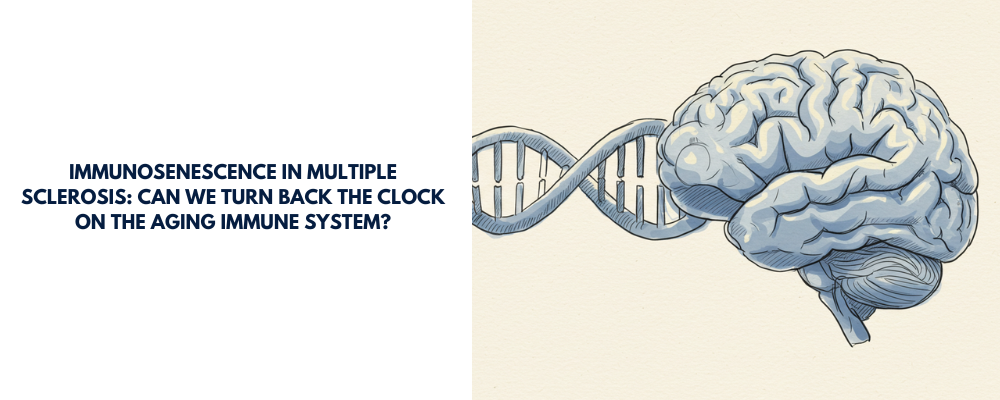Immunosenescence in Multiple Sclerosis: Can We Turn Back the Clock on the Aging Immune System?

As the world's population ages, so does the number of individuals living with multiple sclerosis (MS). Thanks to advances in medicine, people with MS are living longer, but current treatments primarily focus on managing relapses and slowing disease progression rather than stopping disability accumulation. This reality has led researchers to explore the role of immunosenescence, the age-related decline of the immune system, in MS. A recent review article in *Autoimmunity Reviews* delves into how immunosenescence affects immune cell function and its involvement in autoimmune diseases, particularly MS, further discussing potential therapeutic strategies to rejuvenate the immune system.
Understanding Immunosenescence
Immunosenescence is a complex process characterized by changes in immune cell function and a reduced response to new infections and vaccines. Hallmarks of this process include:
* Inversion of the CD4:CD8 ratio
* Expansion of CD8+CD28− T cells
* Cytomegalovirus (CMV) seropositivity
* Poor T cell proliferation
* Low B cell numbers
These changes are collectively known as the immune risk phenotype and are associated with increased morbidity and mortality in older adults.
How Immunosenescence Impacts the Immune System
The aging immune system undergoes several changes affecting both adaptive and innate immunity:
* Adaptive Immunity:
* T cells: Thymic involution reduces naïve T cell production and T cell receptor (TCR) diversity. Memory T cells accumulate, and senescent T cells exhibit impaired proliferation and secrete pro-inflammatory cytokines.
* B cells: B cell production and B cell receptor (BCR) diversity decrease. There's a shift from naïve to memory B cells, and age-associated B cells (ABCs) that produce autoantibodies expand.
* Innate Immunity:
* Monocytes/Macrophages: Monocytes show reduced production of antiviral and inflammation-related factors. Macrophages polarize towards an anti-inflammatory M2 phenotype, and antigen presentation is impaired.
* Dendritic Cells (DCs): DCs exhibit mitochondrial dysfunction, increased production of reactive oxygen species (ROS), and impaired antigen processing, resulting in reduced stimulation of CD8+ T cells.
* Natural Killer (NK) Cells: The balance of NK cell subtypes shifts, with a decrease in CD56bright immunoregulatory cells and an increase in CD56dim cytotoxic cells, alongside a defective degranulation capacity.
* Neutrophils: Aged neutrophils show a reduced ability to target infected tissue and generate ROS and neutrophil extracellular traps (NETs).
Immunosenescence and Autoimmunity
Immunosenescence contributes to inflammaging, a chronic, low-grade inflammation that increases susceptibility to inflammatory diseases. This is due to the accumulation of cell debris and self-antigens, leading to a sustained immune response. Unusual cell subsets, such as senescent CD4+CD28− T cells and ABCs, emerge and promote autoreactivity. Genetic and environmental factors, such as HLA haplotype, viral infections, and medication use, can accelerate immunosenescence and contribute to autoimmune diseases.
Immunosenescence in Multiple Sclerosis
MS, a chronic neurodegenerative disease with presumed autoimmune origin, is characterized by immune-mediated destruction of myelin sheaths in the central nervous system (CNS). Studies suggest that MS progression is associated with premature immunosenescence.
Several factors contribute to MS development, including genetic and environmental factors. The autoimmune response in MS involves CD4+ T cells reactive to myelin antigens that infiltrate the CNS, leading to demyelination and tissue damage. Molecular mimicry with Epstein-Barr virus (EBV) antigens is one of the main mechanisms involved in MS pathogenesis.
As the prevalence of MS increases with the aging population, researchers have observed that current treatments cannot halt disability accumulation, suggesting a link between aging and disease progression. Studies in experimental autoimmune encephalomyelitis (EAE), an animal model of MS, and in MS patients demonstrate the impact of immunosenescence on the disease.
Therapeutic Strategies to Rejuvenate the Immune System in MS
Given the influence of premature immunosenescence on MS progression, researchers are exploring therapeutic strategies to rejuvenate the immune system. These strategies include:
* Senolytics and HSC Regenerative Strategies: Senolytic drugs selectively remove senescent cells, potentially reversing the effects of immunosenescence. HSC aging is related to reduced self-renewal capacity, which leads to altered immune cell numbers and functions. Strategies that enhance the regenerative capacity of HSCs can re-establish a more youthful immune system.
* Rejuvenation of Oligodendrocyte Precursor Cells (OPCs), Microglia, and Monocytes: Promoting remyelination by rejuvenating OPCs and enhancing myelin debris clearance by microglia and monocytes could help combat the neurodegenerative effects of MS.
* Rejuvenation of the Thymus: Restoring aged thymic function can improve T cell development and reduce autoreactive T cell production. Strategies include targeting the FOXN1 transcription factor, treatment with IL-7 and IL-22, and therapeutic vaccinations.
* Rejuvenation of Senescent B and T Cells: Targeting senescent B and T cells, such as with anti-BAFF treatment to reduce ABCs or telomerase activators to lengthen telomeres, may help restore immune function.
The Future of MS Treatment: Targeting Immunosenescence
The evidence suggests that age-related immune changes and premature immunosenescence play a significant role in MS progression. Therapeutic strategies focused on rejuvenating the immune system offer new opportunities for treating MS, particularly the progressive forms of the disease. A deeper understanding of the impact of aging on the immune system in MS patients will facilitate the development of effective immunotherapies against immunosenescence.
Disclaimer: This blog post is based on the provided research article and is intended for informational purposes only. It is not intended to provide medical advice. Please consult with a healthcare professional for any health concerns.
Reference:
Dema, M., Eixarch, H., Villar, L. M., Montalban, X., & Espejo, C. (2021). Immunosenescence in multiple sclerosis: the identification of new therapeutic targets. Autoimmunity Reviews, 20(9), 102893.
